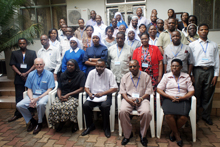
Training Health Workforce Managers to Use Health Workforce Information in Tanzania
In the health sector, a human resources information system (HRIS) is only powerful if data from the system are used to make decisions that address issues affecting the health workforce or otherwise support health workers. This year, CapacityPlus added several features and modules to iHRIS Manage—a system that maintains health worker deployment, management, and attrition information—to advance its use from merely tracking employed health workers to strengthening the daily management of health workers.
As iHRIS Manage is open source, countries can customize it for local needs. In Tanzania, the Tanzania Human Resource Capacity Project (THRP), led by IntraHealth International, modified the software for the Christian Social Services Commission (CSSC). CSSC is an umbrella organization that provides technical assistance to its member organizations and their affiliates. CSSC’s HRIS contains data on nearly 18,000 health professionals working in the faith-based and private-for-profit sectors. CapacityPlus is now collaborating with THRP to strengthen the understanding and use of the system.
CapacityPlus’s Doris Mwarey recently facilitated a pilot human resources management (HRM) training for HRIS users, along with Scott Todd of IMA World Health. Mwarey is an HR technical advisor with the Africa Christian Health Associations Platform, a position supported by CapacityPlus, while Todd is an HMIS/GIS officer and has been instrumental in working with THRP to implement the HRIS at the CSSC. Other trainers included Bakari Bakari and Angelina Ballart of THRP, Petro Pamba of CSSC, and Killian Issuja of the Benjamin William Mkapa HIV/AIDS Foundation. The four-day training aimed to enhance the use of the HRIS for the day-to-day management of health workers at the facility level, which includes recruitment and deployment, performance management, workforce planning, career development, and reporting of health worker accidents.  Thirty-eight health facility managers and other stakeholders from Tanzania’s Eastern Zone participated in the training and learned HRM skills needed for integrating HRIS with health workforce interventions and using data for decision-making.
Thirty-eight health facility managers and other stakeholders from Tanzania’s Eastern Zone participated in the training and learned HRM skills needed for integrating HRIS with health workforce interventions and using data for decision-making.
The training methodology included:
- Combination of theory and practical applications
- Utilization of HRIS data in role play and practical application of HRM skills gained through the training
- Creation of a follow-up plan and feedback mechanism to ensure continued application of skills learned
- Use of local context examples and everyday scenarios for demonstration
- Inclusion of IT technicians and HRIS coordinators in the training to enhance continuous system improvement based on emerging health workforce needs.
The training is being modified based on participant feedback, which was overwhelmingly positive. One participant who manages a new facility noted, “It will now be easier for me to introduce the culture of utilizing the HRIS from the beginning, as part and parcel of managing and organizing the hospital!” CSSC, along with BAKWATA (The National Muslim Council of Tanzania) and The Association of Private Health Facilities in Tanzania, is working to expand the training to the country’s other zones.
Related items:
Photo courtesy of Doris Mwarey and Craig Hafner. (All the training participants)


